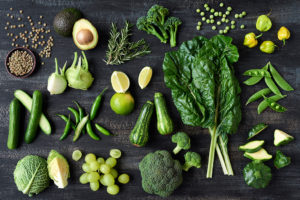
What color food should you probably be eating more?
Green.
And we’re not talking about the green, button-shaped chocolate candies we all know and love.
“The research shows that most Americans are not getting enough of those leafy greens, or vegetables in general,” said Jessica Corwin, a Spectrum Health registered dietitian.
Corwin wants to help change that.
Leafy greens—think spinach, lettuce, kale and collard greens—along with cruciferous vegetables like cauliflower, broccoli, kale, bok choy and Brussel sprouts are considered some of the healthiest vegetables available.
“They are two powerhouses when it comes to nutrition,” Corwin said.
Leafy greens are nature’s super foods, containing healthy doses of fiber and antioxidants, as well as many nutrients and minerals.
And because they’re low in calories, they can help you manage your weight while also lowering your risk of heart disease and cancer. The folate in greens can even help lower depression and boost mental health, Corwin said.
They work in part by helping to lower inflammation in our bodies, she said.
“Inflammation is linked to everything,” Corwin said. “Anything that we can do to fight off inflammation with our food choices is going to be beneficial.”
While any green is good, you want to go beyond just the occasional slice of iceberg lettuce on your sandwich, Corwin said.
Not all greens are equal.
The darker, the better.
Romaine and iceberg, both lighter-green lettuces, have their place in a healthy diet. But they’re not going to pack the same nutritional punch as other rich-colored lettuces.
“Generally with leafy greens, the heavier they are in nutrients, the brighter the color,” Corwin said. “We want to eat the rainbow.”
Go for kale, spinach, collard greens, arugula, Swiss chard and more.
At most grocery stores, there’s a wide selection of spring mixes and other lettuce mixes to choose from.
Corwin is even a fan of ready-made salad kits. The dressings included in these kits aren’t as healthy as a homemade dressing, but having all the fixings for a salad that’s ready to go can encourage more people to eat it in the first place, she said.
And the best salad is one you’ll eat and enjoy.
“It takes the mental load off if your salad is already thrown together for you,” she said
If you love romaine and are not up for trying other lettuces, try mixing them together with kale or another darker green lettuce, she said.
Kale is often lauded as one of the healthiest greens out there. There’s good reason for that. It contains vitamin A, vitamin C, calcium, fiber and folate.
You can throw it in not only salads, but also soups and stir fry.
Corwin also suggested roasting it into kale chips, a deliciously popular approach to appease kids.
Bulk kale, which is tied together in bunches in the produce section, can be intimidating for some, Corwin said.
You typically need to massage it with oil or sea salt to soften the texture and create a less bitter flavor. She also recommended dicing it into small bits for a salad.
But there’s also baby kale available in salad mixes. This tastes much the same as other lettuces.
“Any way you can get it in is going to be huge step in the right direction,” Corwin said.
If you can get your kids to eat their leafy greens, that’s even better.
“I have one friend who will hold up some spinach leaves and the kids pretend they are baby giraffes eating leaves off the trees,” Corwin said. “That’s kind of a fun, silly way to get them started young.”
Green smoothies, dipping little endive leaves in ranch dressing, chopping up greens and adding them to foods they like—anything can help get them used to “seeing green” in their food, she said.
“It doesn’t have to be a huge amount,” Corwin said.
Getting kids involved in every facet of the decision-making process and food preparation can encourage healthier eating. Teach them to grow their own greens. Let them pick out fresh foods at a farmers market. Encourage them to help you wash and cook these items.
“For some kids, it’s a big step for them to touch it and smell it,” Corwin said. “The more they get used to it, the more likely they are to try it.”
The same can apply to adults.
Add green wherever you can—throw spinach in your eggs in the morning, put it on your sandwiches, try a new lettuce in your salad, make lettuce wraps for tacos or sandwiches, put it on your pizza.
“However you can, wherever you are, more is always a little better,” she said.
 /a>
/a>
 /a>
/a>
 /a>
/a>